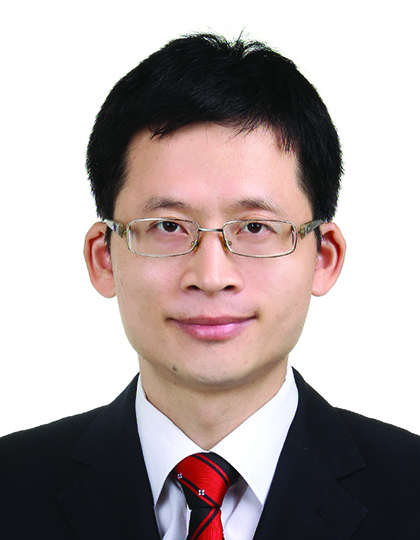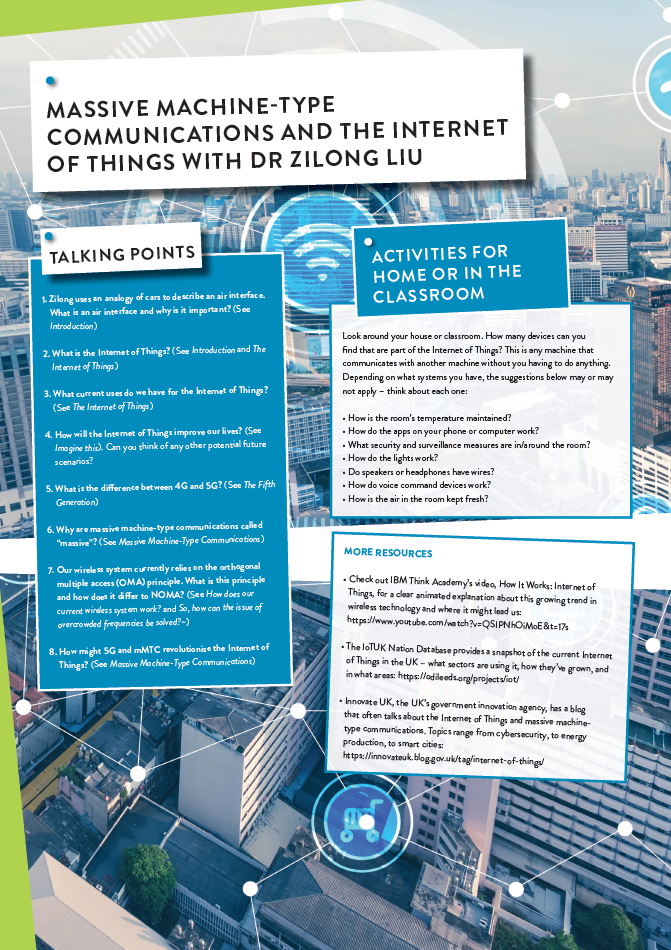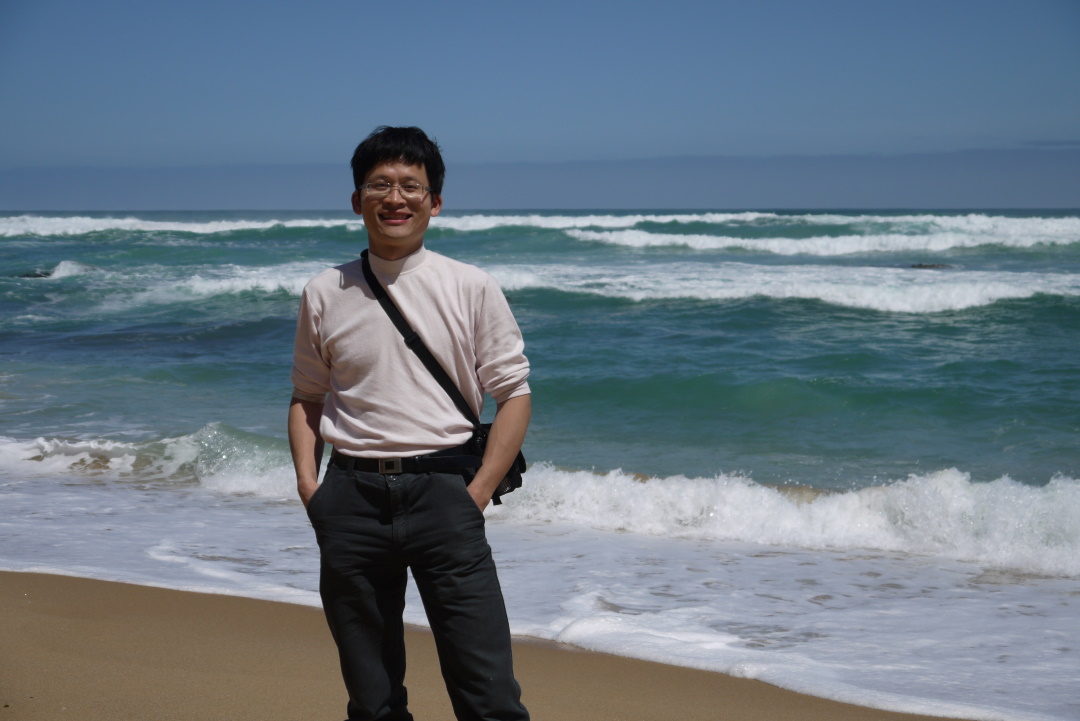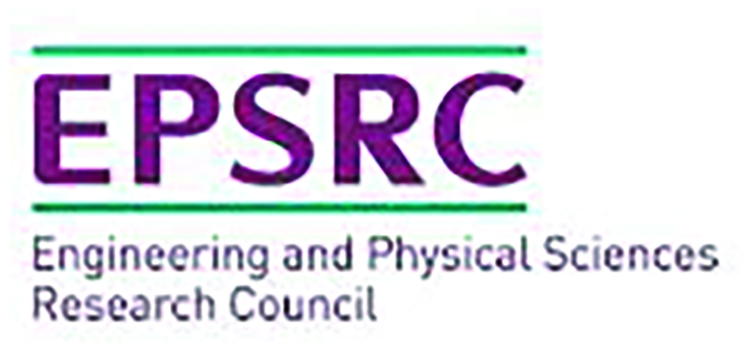Building the Internet of Things for an interconnected world
This is the issue that a team of scientists at the University of Surrey’s 5G Innovation Centre is set on solving, led by Professor Pei Xiao, the principal investigator of the research project. Transmitting data wirelessly involves converting it into radio waves that can travel through the air – this stage is called the air interface. However, the air interface processes wireless signals over very crowded and expensive radio frequencies (called “spectrum bands”), and sending too much data at once over these limited spectrum bands can lead to interference. “It is like sending lots of cars into a narrow street,” says Dr Zilong Liu, a senior research fellow working on the 5G Innovation Centre’s air interface project. “There could be very severe traffic jams if old-fashioned approaches are applied.”
The emails you read, the photos you share online and the films and music you stream are all, in fact, collections of electronic data. To be able to transmit these data over a digital network, they are broken down into tiny pieces and placed in digital or data packages. And, once they reach their destination, the information contained in the packets are reassembled. This is why you might see various parts of a photo coming together as it loads if the internet connection is slow.
As with anything electronic, wireless communications are based on circuits. A change in one device (e.g. the transmission of data) causes a change in another device (e.g. the reception of data). But electrical currents do not travel well through the air; so, to reach devices, the data has to be transformed into something else, namely radio waves.
Up until now, our wireless system has largely avoided interference between different signals by using the orthogonal multiple access (OMA) principle. “Orthogonal” means “at right angles”, and is used to describe data streams that are separated by allocating different radio resources to them – for instance, putting them on different frequencies – so that they cannot be confused with one another. This has worked so far, but as we enter the age of the Internet of Things, the sheer number of device-to-device communications – known as massive machine-type communications (mMTC) – will grow explosively. For example, according to Cisco (a worldwide leader in IT, networking, and cybersecurity solutions), there will be 14.6 billion device-to-device connections by 2022, which is twice the size of the global population. This means that the frequencies used are in danger of becoming clogged up.
SO, HOW CAN THE ISSUE OF OVERCROWDED FREQUENCIES BE SOLVED?
Zilong has a solution. “My research at this stage is focused on the design of multiple access schemes in mMTC networks,” he says. “A key technique in this area is called non-orthogonal multiple access (NOMA).” NOMA can support three to five times more communication links than OMA, by varying either the transmit power (the movement of energy from its place of generation to a location where it is applied) or coding signatures, in addition to the already varied radio resources. This means several data streams can be transmitted on the same frequency band at the same time, because they can be distinguished by these different values (i.e. transmit power, coding signatures). To continue the car analogy, it is like adding an extra dimension – say vertical space, utilising flying cars – that can travel down the same narrow road but at a different “value” (i.e. height) than other cars.
This still does not allow for unlimited simultaneous data streams, but thankfully mMTC does not need them. “Not all communication devices in an mMTC network will be in active transmission mode at all times,” explains Zilong. “Most of them will be in sleep mode except when they “wake up” to exchange data for a small period of time. Moreover, most data transmissions will be done in short packets (e.g., less than 200 bits). These features can be smartly leveraged for a more efficient air interface design.”
Reference
https://doi.org/10.33424/FUTURUM35
This is the issue that a team of scientists at the University of Surrey’s 5G Innovation Centre is set on solving, led by Professor Pei Xiao, the principal investigator of the research project. Transmitting data wirelessly involves converting it into radio waves that can travel through the air – this stage is called the air interface. However, the air interface processes wireless signals over very crowded and expensive radio frequencies (called “spectrum bands”), and sending too much data at once over these limited spectrum bands can lead to interference. “It is like sending lots of cars into a narrow street,” says Dr Zilong Liu, a senior research fellow working on the 5G Innovation Centre’s air interface project. “There could be very severe traffic jams if old-fashioned approaches are applied.”
The emails you read, the photos you share online and the films and music you stream are all, in fact, collections of electronic data. To be able to transmit these data over a digital network, they are broken down into tiny pieces and placed in digital or data packages. And, once they reach their destination, the information contained in the packets are reassembled. This is why you might see various parts of a photo coming together as it loads if the internet connection is slow.
As with anything electronic, wireless communications are based on circuits. A change in one device (e.g. the transmission of data) causes a change in another device (e.g. the reception of data). But electrical currents do not travel well through the air; so, to reach devices, the data has to be transformed into something else, namely radio waves.
Up until now, our wireless system has largely avoided interference between different signals by using the orthogonal multiple access (OMA) principle. “Orthogonal” means “at right angles”, and is used to describe data streams that are separated by allocating different radio resources to them – for instance, putting them on different frequencies – so that they cannot be confused with one another. This has worked so far, but as we enter the age of the Internet of Things, the sheer number of device-to-device communications – known as massive machine-type communications (mMTC) – will grow explosively. For example, according to Cisco (a worldwide leader in IT, networking, and cybersecurity solutions), there will be 14.6 billion device-to-device connections by 2022, which is twice the size of the global population. This means that the frequencies used are in danger of becoming clogged up.
SO, HOW CAN THE ISSUE OF OVERCROWDED FREQUENCIES BE SOLVED?
Zilong has a solution. “My research at this stage is focused on the design of multiple access schemes in mMTC networks,” he says. “A key technique in this area is called non-orthogonal multiple access (NOMA).” NOMA can support three to five times more communication links than OMA, by varying either the transmit power (the movement of energy from its place of generation to a location where it is applied) or coding signatures, in addition to the already varied radio resources. This means several data streams can be transmitted on the same frequency band at the same time, because they can be distinguished by these different values (i.e. transmit power, coding signatures). To continue the car analogy, it is like adding an extra dimension – say vertical space, utilising flying cars – that can travel down the same narrow road but at a different “value” (i.e. height) than other cars.
This still does not allow for unlimited simultaneous data streams, but thankfully mMTC does not need them. “Not all communication devices in an mMTC network will be in active transmission mode at all times,” explains Zilong. “Most of them will be in sleep mode except when they “wake up” to exchange data for a small period of time. Moreover, most data transmissions will be done in short packets (e.g., less than 200 bits). These features can be smartly leveraged for a more efficient air interface design.”
“At the University of Surrey, our work is unique from other groups because we very much care about the practicality of our scientists are not only offering a solution to overcrowded frequencies, they are facilitating technological advances that are applicable in the real world. Understanding where these advances might go, and working out how they can be applied to improve people’s lives, has great potential to make the world a better and more sophisticated place – and the industry is only growing, so the next few years are the perfect time to get involved.
 DR ZILONG LIU
DR ZILONG LIUSenior Research Fellow
5G Innovation Centre, University of Surrey, UK
FIELD OF RESEARCH: Electrical and Electronic Engineering
RESEARCH PROJECT: Zilong and the EPSRC project team are developing new air interface techniques for future massive machine communications. This will help the Internet of Things become a reality.
FUNDER: Engineering and Physical Sciences Research Council
 DR ZILONG LIU
DR ZILONG LIUSenior Research Fellow
5G Innovation Centre, University of Surrey, UK
FIELD OF RESEARCH: Electrical and Electronic Engineering
RESEARCH PROJECT: Zilong and the EPSRC project team are developing new air interface techniques for future massive machine communications. This will help the Internet of Things become a reality.
FUNDER: Engineering and Physical Sciences Research Council
THE FIFTH GENERATION
Each generation of wireless technology is defined by breakthroughs in air interfaces: by increasingly sophisticated encoding methods that mean data can be transmitted at ever greater speeds and volumes through the air. We are now on the cusp of the fifth generation, known as 5G.
Our familiarity with 5G is largely via our mobile phones. Similar to the progression from 3G to 4G, moving from 4G to 5G will vastly increase the amount of data we can transmit or receive, be this face-to-face video calls, streaming films or music videos, or downloading powerful apps. But behind the scenes is another major use for 5G, which is perhaps more likely to revolutionise the way we live. This use is known as massive machine-type communications (mMTC), and is where the Internet of Things enters the picture.
THE INTERNET OF THINGS
The term “Internet of Things” refers to devices (“things”) communicating without the need for human participation. “Machines already talk to each other without us doing anything – think about the apps on your mobile, or the satnav in a car. The Internet of Things is already a reality in our everyday lives,” says Zilong. “For example, traditional wireless sensor networks (which have been used for forest fire detection and battlefield surveillance) may be regarded as an example of Internet of Things. But the size of the future Internet of Things may be far more massive.”
MASSIVE MACHINE-TYPE COMMUNICATIONS
mMTC will involve many thousands of devices communicating wirelessly with each other, without ever needing to involve a human. Such a vast network could streamline huge portions of our lives: our entire systems for transport, healthcare, security and many other sectors could all be interlinked to make collective automated decisions within milliseconds. Zilong gives some examples. “For instance, smart meters for utilities at home can upload meter readings to the cloud automatically without any human intervention; smart sensors in future factories could be capable of monitoring the entire environment of a factory (e.g., pressure, humidity, temperature, or sound) to enable highly productive manufacturing.”
SO, IS THIS A GOOD TIME TO GET INTO ELECTRICAL AND ELECTRONIC ENGINEERING?
Modern life is hugely reliant on electricity and, as we enter the age of smart technologies, this reliance is set to increase. Electrical and electronic engineers are, and will continue to be, in high demand. Working at the forefront of practical technology, experts in this field are responsible for improving the devices and systems we use every day – from mobile phones to renewable energy.
WHAT IS THE DIFFERENCE BETWEEN ELECTRICAL AND ELECTRONIC ENGINEERING?
To put it simply, electrical engineers deal with the supply and demand of power; whereas electronic engineers create, design and test electronic devices. Many university courses bundle the electrical and electronic engineering together. If you love technology and are excited about future technological advances – and their potential benefits to society – then following Li in his footsteps could be the path for you!
• Electrical and electronics engineers have skills that are useful across a wide range of industries, including research and development, telecommunications, engineering services, manufacturing and government.
• According to Glassdoor, the average UK salary for an electronics engineer is £35.5k a year.
• Generally, employers in the field look for a bachelor’s degree at a minimum. According to The Complete University Guide, the current top five UK universities for electrical and electronics engineering are Cambridge, Oxford, Imperial College London, Leeds and Glasgow.
• There are many internship schemes taking place across the UK, requiring varying levels of qualifications to secure. Well-known companies offering internship positions include Arm, General Motors, BAE Systems and many more.
WHAT DID YOU WANT TO BE WHEN YOU WERE YOUNGER?
When I was young, we didn’t have the internet and the world was not as connected as it is today. To be frank, I cannot recall what I wanted to be. I was very innocent but also curious about the entire world. As I came from a humble background, I studied very hard in order to get into a top university.
WHAT INSPIRED YOU TO PURSUE ELECTRICAL AND ELECTRONIC ENGINEERING?
A degree in electrical/electronic engineering can lead you to an engineering job with decent pay. Perhaps this is what motivated me to enter this field. After my undergraduate study, I was very fortunate to receive an MSc scholarship from Tsinghua University (one of China’s top universities), where I trained to become a digital integrated circuit (IC) design engineer. But I wasn’t very good at working in the IC design industry, which is fast-paced. In July 2008, I was offered an associate research position with Prof Guan Yong Liang at Nanyang Technological University in Singapore. It was through this position that I completed a part-time PhD with distinction. For me, my time spent in Singapore was very happy.
HOW WOULD YOU DESCRIBE YOURSELF?
I regard myself as somebody with enormous amounts of curiosity and passion, which are key personality traits for scientific discovery. Also, my team spirit and willingness to contribute brings me into contact with a lot of collaborators from Asia-Pacific and Europe.
WHAT WOULD YOUR IDEAL “SMART HOME” LOOK LIKE?
I would like to have a smart home that could fulfil most of my everyday needs but with minimum human intervention. The smart home knows when I will arrive home, when to get my dinner ready, and when to wash all the dishes. It pays all the monthly bills and can even negotiate lower prices and better services from various service providers; for example, energy companies.
The smart home automatically adjusts indoor temperatures and can open and close the windows, based on the season and daily weather reports.
WHAT EXCITES YOU MOST ABOUT THE FUTURE OF mMTC?
mMTC will pave the way for an increasingly intelligent future. I become very excited when, for instance, I imagine myself travelling to London from Guildford in an autonomous car operated with the aid of an mMTC network.
• Get a good foundation in mathematics if you want to get into electrical and/or electronic engineering
• Proficiency in computer programming is also a must
• And, finally, a curious mind and a desire to learn new things is vital







